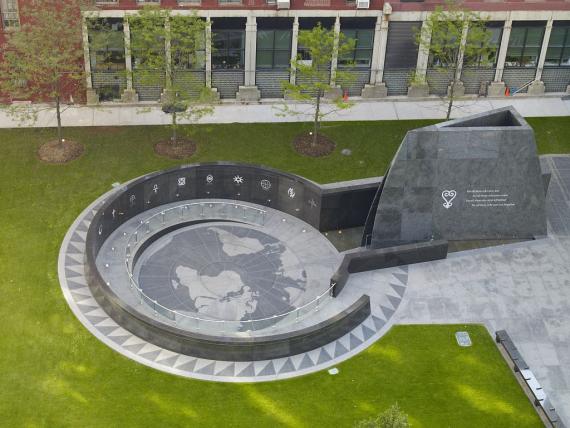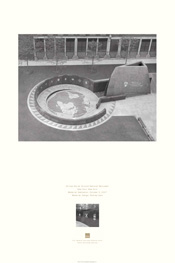In May 1991, a three hundred year silence was shattered with the discovery of the African Burial Ground in lower Manhattan. Widely acknowledged as one of the most significant American archeological finds of the twentieth century, the African Burial Ground discovery redefined the history of New York and exposed an often overlooked heritage. Following the discovery, nearly two decades were dedicated to the documentation and interpretation of the site. A series of events and ceremonies that involved studying and honoring those buried there, returning them to their rightful resting place, and proclaiming the African Burial Ground a National Monument culminated in the 2007 unveiling of a permanent on-site memorial. An enduring cultural and spiritual monument was created.
Prior to the 1991 discovery, plans to erect a 34-story, $276-million federal building required that a cultural resource survey, including archeological field-testing, be completed. Under the National Environmental Policy Act of 1969 and the National Historic Preservation Act of 1966, such research is required on any project using public funds that may have the potential to impact historic resources. During the last days of the excavation, the archeological team discovered a missing chapter of New York history, the first of more than four hundred skeletal remains of men, women, and children, members of the city’s enslaved population, was unearthed.
The African American community, joined by public figures and private individuals, responded immediately, voicing concerns that the African Burial Ground would not be given the reverence it deserved. From the controversy over the proper handling of the burial ground, one of the largest academic research endeavors focused on African Americans began. The Cobb Laboratory at Howard University offered a research plan for the interdisciplinary archeological, bio-anthropological, and historical study that documented the life and culture of New York’s seventeenth and eighteenth-century Africans. Following public input, project stakeholders decided to unearth the four hundred burials, providing valuable information about health, diet, gender, age, physical condition, and cause of death. Under the direction of the U.S. General Services Administration (GSA) and the U.S. Army Corps of Engineers Center of Expertise for the Curation and Management of Archaeological Collections, Howard University produced a multivolume report documenting their unprecedented, and often disturbing, findings.
History and Significance
Slavery in New York began during the 1600s, when the Dutch West India Company brought African slaves to the New Amsterdam colony. England seized New Amsterdam in 1664 and renamed it New York. Slavery continued under British rule. Most of the African slaves came from West Central Africa. After decades of agitation, universal emancipation for all slaves in New York was achieved in 1827. As the Civil War approached, the South became identified with slavery, and the North with free labor. In 1991, the discovery of the African Burial Ground allowed contemporary historians to study the period anew.
Placed in use as a burial ground during the 1640s, the African Burial Ground (historically identified as the “Negroes Buriel Ground”) was within a mile of Manhattan’s southern tip, making it one of the first land holds over which New York Africans had relative control.
Skeletal remains showed that life was perilous for Africans in New York. Nine percent of the burials were children under the age of two, a death rate disproportionately higher than the rest of the population. Further research exposed malnutrition, delayed bone development, backbreaking labor, and recurrent illnesses.
New York Africans lived in poverty, taking little with them to the grave. Funeral practices demonstrate cultural continuity between the New World and Africa. Burials often included bead ornaments, which held ceremonial significance for every stage of life. Shells also had meaning, reflecting the belief that they “enclose the soul’s immortal presence.”
By the 1790s, free African Americans established the African Methodist Episcopal Zion Church and, in 1794, formed the African Society. The Society opened a new cemetery and the African Burial Ground was closed. Although the site was known to be a cemetery, real estate pressures took priority in the rapidly expanding city, and subdividing of the land began in 1795. A street grid, followed by commercial, industrial, and residential development, erased the memory of the cemetery.
Around 1900, lower Manhattan was filled and leveled. By the mid-twentieth century, commercial and government buildings occupied the area, and the African Burial Ground was further sealed. In 1991, the evolution of the site had resulted in a parking lot which subsequently became the proposed site for a federal building. During preconstruction archeological investigations, the African Burial Ground was discovered and immediately recognized for its cultural and historical significance.
In 1993, the African Burial Ground was designated a National Historic Landmark. A decade later, the Schomburg Center for Research in Black Culture hosted the “Rites of Ancestral Return,” a week-long series of events marking the return of human remains and artifacts to the African Burial Ground. In 2006, the African Burial Ground was proclaimed a National Monument. GSA, in conjunction with the National Park Service, installed an interpretive center and public art adjacent to the site.
A memorial site designed by Rodney Leon was completed in 2007. The memorial consists of a sunken Libation Court (gathering space for cultural ceremonies). It is surrounded by a Circle of the Diaspora inscribed with signs, symbols, and images of the African Diaspora. An Ancestral Chamber provides sacred space for contemplation. A Wall of Remembrance describes events that contributed to the African Burial Ground’s creation. The reinterment locations are marked with four Ancestral Pillars.
An important link to the history of New York, the African Burial Ground is possibly the only preserved, urban, eighteenth-century African cemetery in America. The site and memorial also contribute to New York’s cultural richness, adding to an array of monuments celebrating the city’s immigrant communities. While years in the making and not without controversy, the African Burial Ground’s preservation means the contributions of its African ancestors will live on in perpetuity. The African Burial Ground project received a Preserve America Presidential Award in 2008.
Significant Events
- Late 1600s: African Burial Ground first used for burials
- 1800-1900: Development erases evidence of African Burial Ground
- 1900: Grading and filling protects burials from further damage
- 1991: African Burial Ground discovered during site preparation for new federal building
- 1991-2006: Archeological and historical investigations
- 1993: African Burial Ground designated a National Historic Landmark
- 2003: “Rites of Ancestral Return” marks the return of human remains to African Burial Ground
- 2006: African Burial Ground designated a National Monument
- 2007: Dedication of African Burial Ground Memorial
- 2008: African Burial Ground Project receives Preserve America Presidential Award
- 2010: National Park Service visitor center opens
African Burial Ground Facts
- Location: Duane and Elk Streets
- Historic Dates: Late seventeenth through late eighteenth century
- Discovery Date: 1991
- Landmark Status: National Monument
- Dedication Date: October 5, 2007
- Memorial Design: Rodney Leon and AARRIS Architects
Poster Download
Download the Poster [PDF - 116 KB]

 U.S. General Services Administration
U.S. General Services Administration

